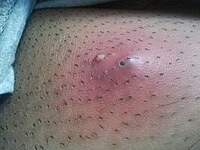
Efficacy of intralesional meglumine antimoniate in the treatment of canine tegumentary leishmaniasis: A Randomized controlled trial
Sign Up to like & getrecommendations! Published in 2023 at "PLOS Neglected Tropical Diseases"
DOI: 10.1371/journal.pntd.0011064
Abstract: Dogs living in areas of Leishmania (Viannia) braziliensis transmission may present canine tegumentary leishmaniasis (CTL) characterized by cutaneous or muzzle ulcers as well as asymptomatic L. braziliensis infection. It is not clear if dogs participate… read more here.
Keywords: canine tegumentary; braziliensis; intralesional meglumine; meglumine antimoniate ... See more keywords

Embryonic toxico-pathological effects of meglumine antimoniate using a chick embryo model
Sign Up to like & getrecommendations! Published in 2018 at "PLoS ONE"
DOI: 10.1371/journal.pone.0196424
Abstract: Leishmaniasis is one of the diverse and neglected tropical diseases. Embryo-toxicity of drugs has always been a major concern. Chick embryo is a preclinical model relevant in the assessment of adverse effects of drugs. The… read more here.
Keywords: model; antimoniate; meglumine antimoniate; chick embryo ... See more keywords

Intralesional treatment with meglumine antimoniate in three patients with New World cutaneous leishmaniasis and large periarticular lesions with comorbidities.
Sign Up to like & getrecommendations! Published in 2017 at "Revista da Sociedade Brasileira de Medicina Tropical"
DOI: 10.1590/0037-8682-0323-2016
Abstract: Although New World cutaneous leishmaniasis is not itself a life-threatening disease, its treatment with systemic antimonials can cause toxicity that can be dangerous to some patients. Intralesional meglumine antimoniate provides a viable, less toxic alternative.… read more here.
Keywords: new world; treatment; periarticular lesions; cutaneous leishmaniasis ... See more keywords

In vivo efficacy of meglumine antimoniate-loaded nanoparticles for cutaneous leishmaniasis: a systematic review.
Sign Up to like & getrecommendations! Published in 2021 at "Nanomedicine"
DOI: 10.2217/nnm-2021-0119
Abstract: Background: Nanotechnology is a promising strategy to improve existing antileishmanial agents. Objective: To explore the evidence of encapsulated meglumine antimoniate for cutaneous leishmaniasis treatment in animal models. Materials & methods: The studies were recovered from PubMed,… read more here.
Keywords: cutaneous leishmaniasis; systematic review; antimoniate; meglumine antimoniate ... See more keywords

Efficacy of Spironolactone Treatment in Murine Models of Cutaneous and Visceral Leishmaniasis
Sign Up to like & getrecommendations! Published in 2021 at "Frontiers in Pharmacology"
DOI: 10.3389/fphar.2021.636265
Abstract: Translational studies involving the reuse and association of drugs are approaches that can result in higher success rates in the discovery and development of drugs for serious public health problems, including leishmaniasis. If we consider… read more here.
Keywords: leishmaniasis; treatment; efficacy; visceral leishmaniasis ... See more keywords

Hoigne Syndrome Caused by Intralesional Meglumine Antimoniate
Sign Up to like & getrecommendations! Published in 2017 at "Open Access Macedonian Journal of Medical Sciences"
DOI: 10.3889/oamjms.2017.136
Abstract: Hoigne syndrome (HS) is the term coined to describe an acute, non-allergic, psychiatrically based reaction occurring with a wide list of medications, mainly antibiotics. Since its first description by Hoigne and Schoch in 1959, few… read more here.
Keywords: intralesional meglumine; syndrome caused; caused intralesional; hoigne syndrome ... See more keywords

Comparison Of Oral Dapsone With Intramuscular Meglumine Antimoniate In Cutaneous Leishmaniasis.
Sign Up to like & getrecommendations! Published in 2022 at "Journal of Ayub Medical College, Abbottabad : JAMC"
DOI: 10.55519/jamc-04-10265
Abstract: BACKGROUND Many drugs are effective are used as second line treatment for cutaneous leishmaniasis. Dapsone therapy is tolerated well and cost effective. The aim of present study is to determine the efficacy of oral dapsone… read more here.
Keywords: dapsone; intramuscular meglumine; treatment; cutaneous leishmaniasis ... See more keywords